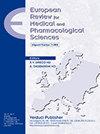P Cavellini, L Andreatta, F Alì, G Bavetta, P Veruggio, A Cesca, D Righi, V Farina, M Berardini, M Iorio, C Zambelli, M Iorio, F Gianfreda, A Palermo, E Minetti
求助PDF
{"title":"使用牙齿作为移植材料的一系列窝保存程序的组织学评价。","authors":"P Cavellini, L Andreatta, F Alì, G Bavetta, P Veruggio, A Cesca, D Righi, V Farina, M Berardini, M Iorio, C Zambelli, M Iorio, F Gianfreda, A Palermo, E Minetti","doi":"10.26355/eurrev_202508_37370","DOIUrl":null,"url":null,"abstract":"<p><p>OBJECTIVE: In this multicenter study, we assessed the effectiveness of a novel autologous bone substitute obtained directly from the processing of extracted teeth. A total of 34 consecutive tooth grafting procedures were performed. MATERIALS AND METHODS: Immediately following atraumatic extraction for restorative or endodontic purposes, the bone defect was filled and covered with an Osseoguard© membrane, using autologous material derived from the extracted tooth. Zimvie T3 PRO© implants with platform switching were placed in 34 patients. RESULTS: After a 5-month healing period, the defects were significantly filled with newly formed hard tissue. Bone biopsies were subsequently taken during dental implant placement to assess histological outcomes. The tissue demonstrated a density comparable to medium-density bone, with a homogeneous and uniform appearance, showing no visible signs of inflammation. The post-operative healing phase was uneventful, with no infectious complications or evidence of graft particles within the regenerated bone structure. Histomorphometric analyses revealed the following results: average bone volume (BV) of 52.35% (±17.25). The average residual graft (RG) rate was 10.79% (±12.26), while new bone (NB) accounted for 41.56% (±22.02) of the samples. CONCLUSIONS: Bone grafts resorb very quickly, while xenograft materials maintain space over time, facilitating bone regeneration. Unfortunately, xenograft materials are not osteoinductive, meaning they do not stimulate bone growth; rather, they provide a supportive structure for new bone formation. The findings of the current study revealed a significant increase in three-dimensional bone volume and a substantial percentage of vital bone formation across all socket preservation sites. The possibility of transforming the extracted tooth of the patient chairside into suitable osteoinductive grafting material offers interesting perspectives in the field of bone regeneration for dental implant purposes. The study demonstrated successful bone healing in guided regenerative surgery procedures utilizing autologous tooth grafts. However, further research with an extended follow-up period is necessary to fully evaluate the potential of demineralized dentin autografts.</p><p><strong>Graphical abstract: </strong>https://www.europeanreview.org/wp/wp-content/uploads/14062-Graphical-abstract-1-scaled.jpg.</p>","PeriodicalId":12152,"journal":{"name":"European review for medical and pharmacological sciences","volume":"29 8","pages":"404-413"},"PeriodicalIF":3.3000,"publicationDate":"2025-08-01","publicationTypes":"Journal Article","fieldsOfStudy":null,"isOpenAccess":false,"openAccessPdf":"","citationCount":"0","resultStr":"{\"title\":\"Histological evaluations of a series of socket preservation procedures using tooth as graft material.\",\"authors\":\"P Cavellini, L Andreatta, F Alì, G Bavetta, P Veruggio, A Cesca, D Righi, V Farina, M Berardini, M Iorio, C Zambelli, M Iorio, F Gianfreda, A Palermo, E Minetti\",\"doi\":\"10.26355/eurrev_202508_37370\",\"DOIUrl\":null,\"url\":null,\"abstract\":\"<p><p>OBJECTIVE: In this multicenter study, we assessed the effectiveness of a novel autologous bone substitute obtained directly from the processing of extracted teeth. A total of 34 consecutive tooth grafting procedures were performed. MATERIALS AND METHODS: Immediately following atraumatic extraction for restorative or endodontic purposes, the bone defect was filled and covered with an Osseoguard© membrane, using autologous material derived from the extracted tooth. Zimvie T3 PRO© implants with platform switching were placed in 34 patients. RESULTS: After a 5-month healing period, the defects were significantly filled with newly formed hard tissue. Bone biopsies were subsequently taken during dental implant placement to assess histological outcomes. The tissue demonstrated a density comparable to medium-density bone, with a homogeneous and uniform appearance, showing no visible signs of inflammation. The post-operative healing phase was uneventful, with no infectious complications or evidence of graft particles within the regenerated bone structure. Histomorphometric analyses revealed the following results: average bone volume (BV) of 52.35% (±17.25). The average residual graft (RG) rate was 10.79% (±12.26), while new bone (NB) accounted for 41.56% (±22.02) of the samples. CONCLUSIONS: Bone grafts resorb very quickly, while xenograft materials maintain space over time, facilitating bone regeneration. Unfortunately, xenograft materials are not osteoinductive, meaning they do not stimulate bone growth; rather, they provide a supportive structure for new bone formation. The findings of the current study revealed a significant increase in three-dimensional bone volume and a substantial percentage of vital bone formation across all socket preservation sites. The possibility of transforming the extracted tooth of the patient chairside into suitable osteoinductive grafting material offers interesting perspectives in the field of bone regeneration for dental implant purposes. The study demonstrated successful bone healing in guided regenerative surgery procedures utilizing autologous tooth grafts. However, further research with an extended follow-up period is necessary to fully evaluate the potential of demineralized dentin autografts.</p><p><strong>Graphical abstract: </strong>https://www.europeanreview.org/wp/wp-content/uploads/14062-Graphical-abstract-1-scaled.jpg.</p>\",\"PeriodicalId\":12152,\"journal\":{\"name\":\"European review for medical and pharmacological sciences\",\"volume\":\"29 8\",\"pages\":\"404-413\"},\"PeriodicalIF\":3.3000,\"publicationDate\":\"2025-08-01\",\"publicationTypes\":\"Journal Article\",\"fieldsOfStudy\":null,\"isOpenAccess\":false,\"openAccessPdf\":\"\",\"citationCount\":\"0\",\"resultStr\":null,\"platform\":\"Semanticscholar\",\"paperid\":null,\"PeriodicalName\":\"European review for medical and pharmacological sciences\",\"FirstCategoryId\":\"3\",\"ListUrlMain\":\"https://doi.org/10.26355/eurrev_202508_37370\",\"RegionNum\":4,\"RegionCategory\":\"医学\",\"ArticlePicture\":[],\"TitleCN\":null,\"AbstractTextCN\":null,\"PMCID\":null,\"EPubDate\":\"\",\"PubModel\":\"\",\"JCR\":\"Q1\",\"JCRName\":\"Medicine\",\"Score\":null,\"Total\":0}","platform":"Semanticscholar","paperid":null,"PeriodicalName":"European review for medical and pharmacological sciences","FirstCategoryId":"3","ListUrlMain":"https://doi.org/10.26355/eurrev_202508_37370","RegionNum":4,"RegionCategory":"医学","ArticlePicture":[],"TitleCN":null,"AbstractTextCN":null,"PMCID":null,"EPubDate":"","PubModel":"","JCR":"Q1","JCRName":"Medicine","Score":null,"Total":0}
引用次数: 0
引用
批量引用

 求助内容:
求助内容: 应助结果提醒方式:
应助结果提醒方式:


